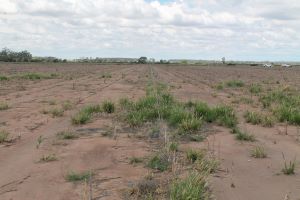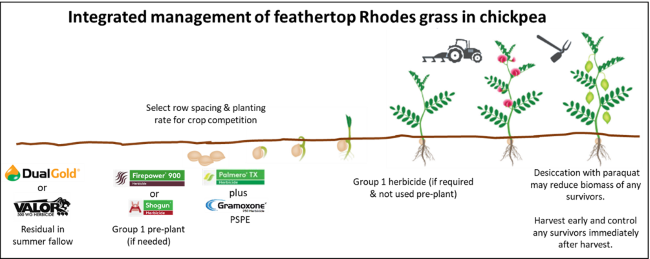Paddock Practices: The role of chickpea in managing feathertop Rhodes grass
Paddock Practices: The role of chickpea in managing feathertop Rhodes grass
Date: 03 Mar 2022

Managing FTR in chickpeas
- Start with a clean summer fallow.
- If weeds are present pre-planting, ensure these are controlled with a double knock
- Narrow row-spacing and higher plant density will provide additional crop competition later in the crop
- Use a robust and effective PSPE herbicide application e.g. Palmero® TX + paraquat
- Control any escapes in-crop via inter-row cultivation or chipping
- Desiccate and harvest early to minimise seed set from any late season weeds.
The key strategy for successful feathertop Rhodes grass (FTR) management is to exhaust the seed bank in the soil. Research has shown that FTR seed viability is typically less than 2 years. This means that FTR populations can be rapidly reduced if new seed incursions are prevented.
This is a somewhat frustrating and ongoing battle, as the lightweight FTR seed is easily spread across the landscape via windstorms, overland water flow and on the hides of livestock and native fauna, so removal of new plants will need to be maintained on an ongoing basis.
However, most FTR seed typically comes from plants that are already within, or adjacent to, the paddock that have been let go to seed. Plants that are able to set seed contribute massive quantities of viable seed to the soil seed bank. One or two seasons of FTR seed ‘blow-outs’ can result in a paddock being quickly overrun.
For this reason, growers dealing with FTR problems should look for crop rotational solutions that have a high likelihood of obtaining complete suppression of FTR right through to harvest. Equally important is the avoidance of crops with inadequate control options that may lead to FTR plants establishing in the crop and setting seed.
Where chickpea suits the farming system and location, it can be an excellent crop choice for paddocks with a known FTR seedbank. With the diversity of FTR management tools available in chickpea, there is a high expectation that the paddock can be managed to prevent any FTR seed production for almost a complete 12-month period. This should result in a large reduction in the FTR seedbank where further seed replenishment has been eliminated for this period.
Setting up for chickpea – the summer fallow
Management strategies will be most effective if the summer fallow starts clean of FTR. This will require good management of FTR in the preceding winter crop. Or, in the case of long fallow, applying residual herbicides before the first spring rainfall events.
If FTR is present at the start of the fallow period, then these will need to be removed early. If weeds are small and there is good soil moisture, then a double knock strategy can be effective. For example, applying a Group 1 herbicide such as Firepower® 900 or Shogun® as the first pass, followed by paraquat in approximately 7 days. Where larger plants are present it is more likely that an optical sprayer or cultivation will be required.
Once existing plants have been controlled, an effective residual herbicide should be applied before the next rainfall. If a double knock has been used to remove any existing plants, then the second pass of this program is an ideal timing to include the residual herbicide.
Valor® (Group 14); Dual® Gold (Group 15); Balance® (Group 27) or Palmero® TX (Group 27+5) are all effective residual herbicides for FTR control in summer fallow leading into chickpea. Each of these herbicides should be expected to provide at least 6-10 weeks residual control at their registered label rates, with length of control mostly depending upon the amount and frequency of rainfall over summer. While all residual herbicides need some soil moisture to work, in drier years the residual period of control may be extended due to slower herbicide degradation.
Individual situations will determine the choice of which herbicide to use. Generally, Group 27 herbicides (e.g. Balance, Palmero TX) will be applied at planting of most chickpea crops, so typically it is not recommended to also apply these in the preceding fallow for reasons of good herbicide resistance management.
Valor provides residual control of a wider range of broadleaf species than Dual Gold, so may be a preferred choice depending on weed spectrum and paddock history. Where there is a long fallow leading into chickpea, one strategy might be to apply Dual Gold in early spring, followed by Valor in early summer, with the objective of maintaining a clean fallow through to planting.
Ideally, the use of a residual herbicide strategy will keep the paddock largely free of FTR right up until planting.
Weeds that escape control by the pre-emergent herbicides in the fallow, must be controlled while still as young as possible. The use of optical sprayers to selectively target low density weed populations is paramount to being able to deliver effective herbicide products and rates, without blowing the budget.
Should there be any late autumn FTR emergence then this may require a Group 1 application prior to planting.
Avoid overuse of Group 1 herbicides
Resistance to Group 1 herbicides (sometimes referred to as ‘FOPs’ and ‘DIMs’) is common in many grass weed species. While these herbicides have typically only been used for less than 10 years targeting FTR control, there are already populations of FTR across Queensland and New South Wales that have been confirmed to be resistant to this mode of action.
As most other knockdown herbicides are not effective on FTR, it is tempting to want to use this mode action during the summer fallow, again prior to planting, and potentially also early post-emergent within the chickpea crop to clean up any survivors.
It is important that we minimise the use of this mode of action to delay resistance. Strategies which will help to achieve this are
- Limit use to a maximum of 1 application per crop (included the fallow preceding the crop).
- For application in fallow (without the benefit of additional crop competition) always follow a Group 1 herbicide application with a double knock e.g. paraquat.
At planting
Chickpea soon after establishment is generally considered to be a relatively poor competitor against weeds that emerge at planting or early in the crop, as they’re likely to be highly competitive. Additionally, chickpea may often be planted deep (moisture seeking), which increases the days to emergence, further reducing early competition with weeds.
However, planting on narrow rows and at higher plant densities has consistently been shown to both maximise yields and provide useful levels of crop suppression of weeds – particularly later in the season.
For these reasons, it is common to ensure that a robust residual herbicide application is applied at planting to enable the crop to establish in a weed-free environment and remain weed free until row-closure.
One of the most common residual herbicide strategies for chickpea is the application of an isoxaflutole herbicide (Group 27) applied post-sowing, pre-emergent (PSPE), usually in combination with a Group 5 triazine herbicide (e.g. simazine, terbuthylazine) to broaden the weed spectrum. Palmero TX is a preformulated mix of isoxaflutole and terbuthylazine which consistently provides residual control of FTR when applied PSPE in chickpea.
If weeds are present at planting then a knockdown herbicide strategy may also be needed. Commonly this may be a double knock program with the first application (often glyphosate or a Group 1 – depending on the weeds to be controlled) being applied prior to planting and the second paraquat application being applied PSPE, in combination with the residual herbicide.
Recent research by Dr Bhagirath Chauhan (QAAFI) has shown that mixing isoxaflutole and paraquat is likely to improve the knockdown of any emerged FTR plants that may be present during this application, compared to either product applied alone.
During the crop
Typically, FTR prefers warmer temperatures for optimum germination. However, FTR may still germinate in substantial numbers in winter months following rainfall.
An effective residual application applied at planting should allow the chickpea crop to establish weed-free. Once full canopy cover and row closure has occurred, the competitive environment coupled with the remaining residual herbicide from planting, should generally maintain the crop free of FTR through to harvest.
Should the choice of at-planting residual herbicide not be effective on FTR (wrong product choice; wrong application rate; other environmental situations affecting performance) and FTR have established within the crop, then it will be important that these are removed as soon as they are noticed. Examples include where wider row spacings have been used with ensuing poorer levels of crop competition, or when no pre-emergent herbicide (isoxaflutole) is applied. Even low numbers of FTR plants may add significant weed seeds to the seedbank if not controlled.
Where FTR has germinated prior to row-closure, inter-row cultivation can be an effective tool as FTR is a shallow rooted species and relatively easy to remove. If there is only the isolated plant that has established early in the crop, then these plants may be large and easy to identify prior to harvest. These plants should be removed with a chip hoe prior to setting seed.
No Group 1 herbicides are registered specifically for control of FTR in chickpea crops, however several are registered for control of other grass weeds. Observations suggest that some of these may be useful when targeting other grass weeds. However, due to potential for resistance selection against this mode of action, the use of Group 1 herbicides should be limited wherever possible and only used as a last resort, after all other options have previously been exhausted.
Desiccation
Most chickpea crops will receive a herbicide desiccation / defoliation application prior to harvest. This is primarily to dry down the crop and improve harvest efficiency, however this application may also provide some useful desiccation of any weeds present.
Chickpea desiccation is likely to be one of either glyphosate (+/- metsulfuron); paraquat; diquat; or Sharpen® herbicides. While none of these herbicide options are highly effective on FTR, paraquat is likely to be the best of available options to provide some level of leaf necrosis and seed set delay on any surviving FTR. This may provide time for post-harvest management to remove FTR plants before they have the opportunity to return seed to the soil or at least to reduce the amount of seed that is set.

